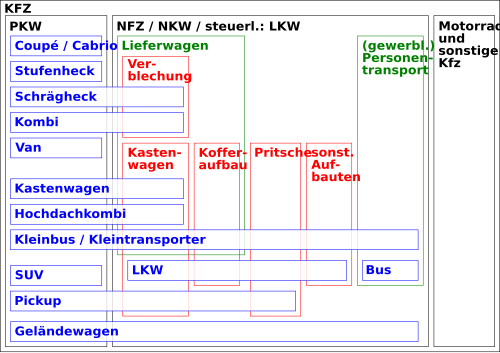Box van

A panel van is a body variant in commercial vehicles with a cargo space that is firmly enclosed on all sides . Panel vans are often used as delivery vans .
Historically, the panel van is one of the oldest standard bodies, from horse-drawn carriages to motorized vehicles . In contrast to the box body , which is mounted on the vehicle frame as a separate unit, the body of the box-shaped structure forms a structural unit with the driver's cab or the driver's workplace. The cargo space is usually separated from the driver's cab by a floor-to-ceiling or half-height partition or a grille.
Often, delivery van versions of cars, i.e. cars without rear side glass panes, but with sheet metal, are also referred to as "panel vans" (analogous to the different variants of small vans: "panel van", "double cab", "station wagon" (for passenger transport)) .
In Germany, panel vans are treated like trucks for tax purposes regardless of their size and are therefore taxed according to their gross vehicle weight and not according to their cubic capacity.
Since around the beginning of 1990, when defining box vans, motorhomes based on small vans have also been included in this category. The variety of basic vehicles knows hardly any limits. Due to their automotive usability, these vehicles now represent a not inconsiderable part of the entire leisure vehicle fleet and are becoming more and more popular from year to year.
Panel vans as trucks and small vans
Up to the 1970s, box vans were particularly popular as furniture vans in truck construction , but largely disappeared in favor of separate box bodies with the advent of tiltable truck cabs, since tipping with the permanently attached box would not be possible.
In vans vans are very common, and there is also the above-mentioned separately built truck bodies for the larger vans. Minibuses , box vans and flatbed trucks are usually developed by vehicle manufacturers on the same chassis (see VW Transporter ).
Box vans as small vans: Ford Transit
Box body car
In the passenger car sector, there was a separate vehicle class as the forerunner of the high-roof station wagon : passenger cars with box bodies, such as B. the box duck . In these box vans, the box was still attached in the classic sense, which mostly protruded in width but always in height over the roof of the driver's cab. The body therefore differs significantly from the series car - in contrast to car delivery vans . They are not only available as a delivery van, but also as a five-seater with side windows in a box body, but also without a side door. From these models, the vehicle category of the high-roof station wagon was developed, in which the “driver's cab” and box optically form a unit.
Panel van as a motorhome
The first motorhomes were built in the 1950s on the basis of the VW bus , the prototype of the small van. With the Westfalia Campingbox , one of the first interior fittings for standard small vans was created. In contrast to later interior fittings, it could still be removed from the vehicle in a few simple steps and remained fully functional. In the 1970s, a van that had been expanded to include living facilities and also had sanitary facilities including a toilet and shower was called a motor home . These vehicles are still in production today. They offer more driving comfort and are usually more economical in consumption than larger motorhomes, but the living space is smaller and the living comfort less, as it is limited to the dimensions of the standard small van. The advantage is the high level of suitability for everyday use of the vehicles, the disadvantage is the high price in relation to the vehicle size due to the complex expansion.
Modern mobile homes on Van basis have usually either a fixed high roof or a pop-up roof (also known as pop-top) in order to ensure the state operating headroom. With some models, one or two beds can be set up under this roof.
photos
Citroën AK 400 Fourgonette - based on the "duck"
Citroën Acadiane - based on the Dyane
Citroën C15 - based on the Citroën Visa
Fiat Fiorino I - based on the Fiat 127
Fiat Fiorino II - based on the Fiat Uno
Ford Courier - based on the Ford Fiesta
Ford (Escort) Express - based on the Ford Escort
Opel Combo A - based on the Opel Kadett E.
Opel Combo B - based on the Opel Corsa B
Renault R4 F4 / F6 - based on the R4
Renault Rapid - based on the R5
Seat Inca - based on the Seat Ibiza / Cordoba
Seat Terra - based on the Seat Marbella
Simca 1100 VF2 / Citylaster / Talbot 1100 City truck and Talbot Matra Rancho - based on the Simca 1100
VW Caddy 9KV - identical to the Seat Inca
Terms
There is no exact definition for the terms delivery vans, panel vans and vans. The following overview shows the usage and the overlap - especially that the term "box van" is used in two ways.


















